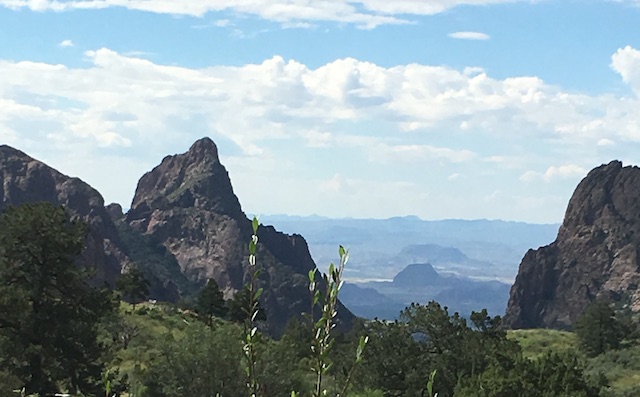
“The Window” view from inside Chisos Mountain Basin in Big Bend National Park.
My husband and I recently visited Big Bend National Park for the first time for both of us. It was an unforgettable experience.
If you’re not familiar with Big Bend National Park, it is 800,000 acres of Texas wilderness comprised of mountains and desert. It abuts the Rio Grande River at the “big bend” in the river, hence the name. It is very remote. It took us about 10 hours to drive there with stops for food, gas, etc. It is the most remote National Park in the lower 48 states- 300 miles from El Paso and about 400 miles from San Antonio. It is also one of the darkest spots in the lower 48 states- terrific for star gazing.
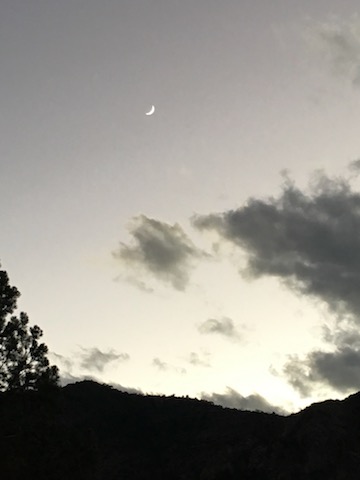
Moonrise
Here’s a link to the park website.
The experience of visiting Big Bend National Park and the surrounding areas is difficult for me to describe. The words used to describe an open, wild or mountainous landscape pale in contrast to the place itself. Nor do pictures give the scope of the grandeur and monument of the landscape.
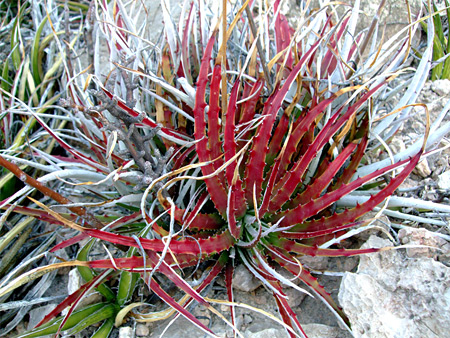
False Agave, Hechtia texensis
AT FIRST GLANCE the number of species of plant life seem not so numerous. Certain species stand out in the rocky desert, seen over and over again: Sotol, Yucca, Agave, Creosote Bush. These are easily seen when driving along the roads in the Park. But, when walking, many more, smaller plants can be seen and examined closely.
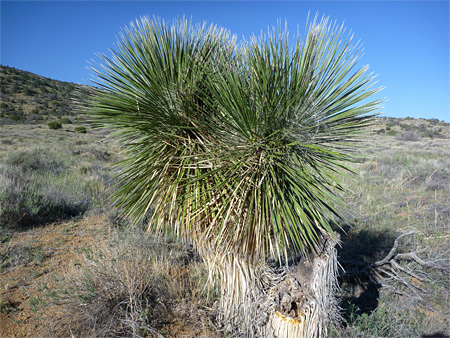
Soaptree Yucca, Yucca elata. Roots used to make soap.
The Uses of Chihuahuan Desert Plants
From the website of University of Texas, El Paso:
“Human societies in desert terrain found numerous ways to sustain themselves through the use of plants that grow there. They harvested seeds, fruits and nuts, and used many other parts of the plants for making household objects, clothing, building shelter, and treating illnesses or injuries. As “modern” society engulfs traditional ones, it is important to preserve the knowledge that our predecessors on this land had – and have – about these native plants.
Prior to the arrival of the Spanish and other colonial settlers, desert survival depended on knowledge of local plants. The new arrivals introduced new plants and new ways of building houses or making clothes, but the use of local plants has continued, especially in rural areas, up to the present day. Native plants are still used by curanderos in treating various ailments – but it is strongly recommended that no one experiment with plants as medicine. The effects are unpredictable and can result in serious problems, even fatalities. Care should also be taken in trying out plants for food – an incorrect identification could give you a stomach-ache, or much worse.”
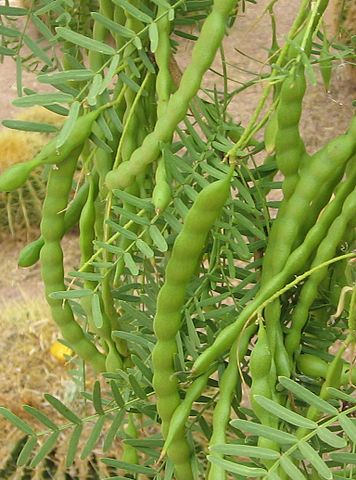
Honey Mesquite (Prosopis glandulosa) Tree with Pods By Don A.W. Carlson – Own work, CC BY 2.5, https://commons.wikimedia.org/w/index.php?curid=2193199
We saw lots of Honey Mesquite Trees in areas where a little water would collect. The Honey Mesquite Tree was perhaps the most important food plant in the Chihuahuan Desert.
The seed, or bean, pods were eaten raw, or collected, ground, mixed with water, and eaten as is or dried into cakes.
No heat was needed to produce this food.
Mesquite flowers and leaves could be boiled up for tea. Various brews of leaves and twigs served as disinfectant for cuts and eyewash for conjunctivitis. Mesquite branches made the best bows. Mesquite firewood was prized – as it is today- for grilling.
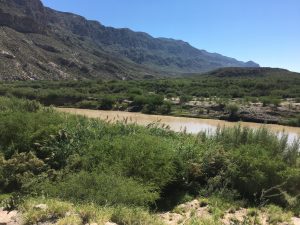
View of the Rio Grande from the Park. Mesquite Trees fill the low lying bank of the river.
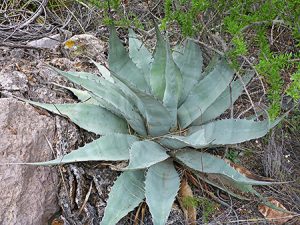
Harvard Yucca: This one puts on a tall flower stalk. We saw a few with spent flower stalks. None in bloom.
There were several species of Agave in the desert, easy to identify.
All parts of the plant were used for food. Even the pineapple-like stem on some types were roasted and eaten- after the leaves were removed. The cooked stem was mashed and eaten. The liquid that was extracted was fermented and made into a beer-like drink called pulque. True Mescal and Tequila are distilled from pulque.
Fibers produced from the leaves by soaking and pounding were used to make bowstrings, clothing, rope, nets, baskets and sandals.
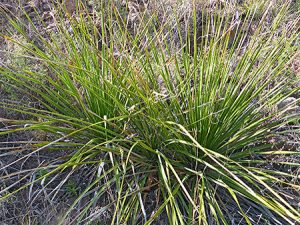
Sotol: This plant was everywhere!
Another Chihuahuan Desert stalwart, the sotol, was also roasted for food, as well as providing fibers, as did the yucca, one of the most useful of desert plants.
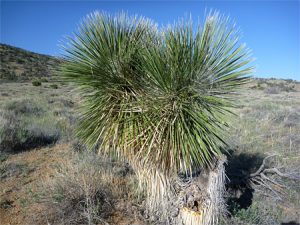
Soaptree Yucca: Roots used to make soap.
Native Americans made soap using the detergent-like compound from the sap of the yucca roots. Yucca stalks, blossoms and seeds were also eaten.
 Creosote Bush (Larrea tridentata) was as common as the yuccas and agaves. It has a strong odor that gives it the name. The morning we left the park, it was fairly early, 8 a.m. or so and we were driving with the windows down. The odor of the creosote bush was very strong due to the dew drying off the plants as the sun rose above the desert.
Creosote Bush (Larrea tridentata) was as common as the yuccas and agaves. It has a strong odor that gives it the name. The morning we left the park, it was fairly early, 8 a.m. or so and we were driving with the windows down. The odor of the creosote bush was very strong due to the dew drying off the plants as the sun rose above the desert.
It is known to repel pests. Stems crushed in water helped reduce the pain of rheumatism. Creosote tea, a foul-tasting liquid, was used to treat tuberculosis, and its vapor inhaled for other respiratory ailments. And the lac insect that lives on the plant provides a shellac-like material for mending pottery and making baskets waterproof.
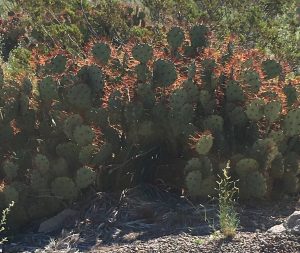
Spiny Fruited Prickly Pear. I love the red spines on this one!
Various cactus species also provided food. The fruits were eaten raw or cooked, and the seeds were ground into meal. The flat pads of the prickly pear
could be eaten after the tiny spines called glocids were rubbed or singed from the jointed stems, which were then boiled. These are known today as nopalitos, and used in many traditional Mexican recipes.
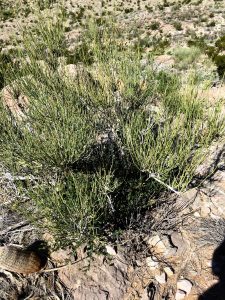
Ephedra (Ephedra spp.) or Mormon Tea
Native Americans were well aware of the medicinal properties of the ephedra plant. An infusion prepared from either green or dried stems treated numerous ailments – canker sores, colds, kidney troubles, and stomach troubles. Dried roots and stems, ground to a powder, were used on wounds and burns.
There are many more plants, of course, in the Chihuahuan Desert in and around Big Bend National Park. I think my favorite plant is the Ocotillo. It looks like a cactus, but it isn’t. It’s a shrub called Fouquieria splendens. It has spiny stems and tiny leaves which come out after rains. The tips sprout red flowers.
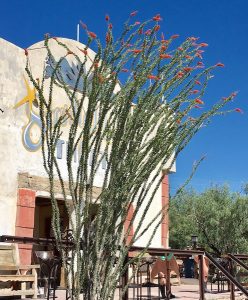
Ocotillo at the Terlingua Trading Company outside the Park.
We saw very few blooming Ocotillo and I was glad to get the picture on the left.
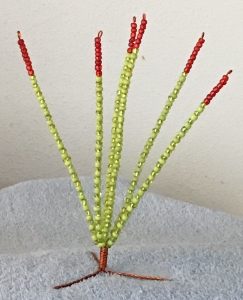
I purchased this little wire and bead sculpture of an Ocotillo at an “illegal” store along a trail overlooking the Rio Grande.
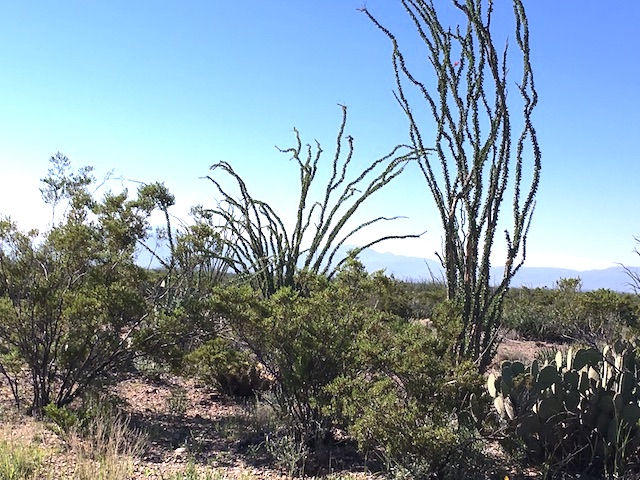
Ocotillo and Creosote Bush along a road in the Park.
Bathing in water that contains crushed flowers or roots of Ocotillo has been used to relieve fatigue.
Native Americans are known to place the flowers and roots of ocotillo over fresh wounds to slow bleeding.
Ocotillo is also used to alleviate coughing, achy limbs, varicose veins, urinary tract infections, cervical varicosities, and benign prostate growths.
The wood is used for firewood and the plant is still used for living fences.
Many of the other dozens of plants I saw in the desert have various uses.
The Desert Willow, (Chilopsis linearis) was widely used for construction, as its pliable wood can be bent into shapes without breaking, and it is very resistant to decay. I have a Desert Willow growing here at my place, that I started from seed many years ago. I was thrilled to see them in their native habitat!
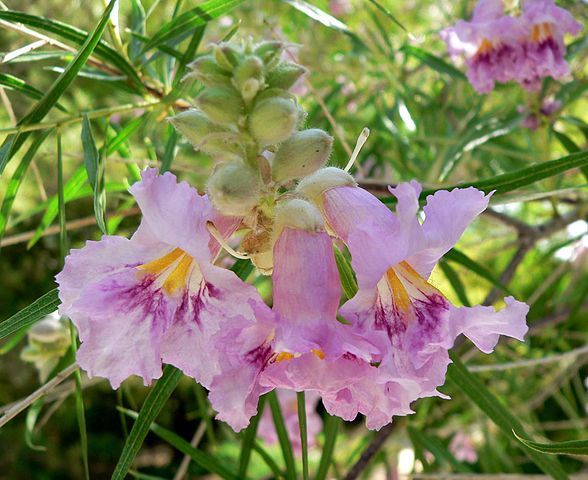
Desert Willow Flower By Stan Shebs, CC BY-SA 3.0, https://commons.wikimedia.org/w/index.php?curid=174367
Bark from trees such as junipers and needles from pines could be turned into fibers for baskets and ropes, and their cones were harvested for edible seeds (piñones).
The plant life is so rich in the desert environment of South Texas. The land, at first glance, looks forbidding, parched and rather uninviting. It takes a certain type of person to live there and appreciate the environs for it’s stark beauty and to accept what is available there.
I hope this is not my last visit to the Big Bend. There is so much more to explore. I would like to visit in the Spring when many more of the cacti and other plants are in bloom.
Please visit the Photo Gallery for many more pictures of the area.
For more detailed information:
How Indians Used Desert Plants by James W. Cornett
Gathering the Desert by Gary Paul Nabhan
Thanks also to Dr. Armando González Stuart of the UTEP/UT-Austin Cooperative Pharmacy Program for his informative guide on medicinal uses of Chihuahuan plants.
QUOTE FOR THE MONTH
There is no such thing as a ‘self-made’ man. We are made up of thousands of others. Everyone who has ever done a kind deed for us, or spoken one word of encouragement to us, has entered into the make-up of our character and of our thoughts.
-George Matthew Adams, newspaper columnist (23 Aug 1878-1962)
